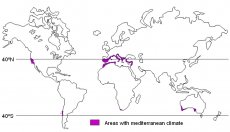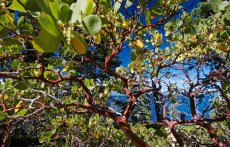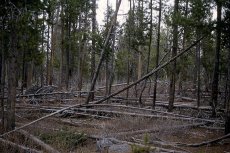Chaparral Environmental Issues
 Overview
Overview
Five regions of the world are defined by a climate with dry summers, and relatively wet winters that receive averages of 15-40 inches of rain per year. These regions are known as a Mediterranean climate. Occurring in Chile, California, South Africa, Europe, and Australia; these areas generally lie on the west coast of continents and are often surrounded by colder water. Many plants have adapted to a particular water regime, accessing moisture for more-or-less the entire year. Mediterranean plants, on the other hand, are selected to survive in annual bouts drought and thrive in conditions that many plants would otherwise perish. Depending on where you are in the world, these Mediterranean plant communities are known by various names. In Europe (primarily Italy) it is known as maquis. In South Africa it is the fynbos. Chile it is called matorral. Australians call theirs mallee. And of course, in California it has been termed chaparral. Dominated by lower growing shrubs with hard leaves and an evergreen habit, Mediterranean shrublands are havens for biological diversity and host nearly ten percent of species in the plant kingdom.
Fig A: Global distributions of Mediterranean climates. Note the 40* north and south latitudes
Chaparral and coastal scrub plants are often mixed up for understandable reasons. Both are shrub communities found in California and often form mosaics with each other in coastal regions where the two overlap. The main differences lies within their water coping strategies and distribution ranges. Chaparral is known to produce tough, evergreen leaves and form deeper root systems that tap into the water table during a drought. In contrast, coastal scrub plants develop softer aromatic leaves that fall off (deciduous) during periods of drought. In addition, coastal scrub plants are confined to lower elevations along the immediate coastline whereas Chaparral environments are found throughout the state and occurs on elevations of up to 5000 feet. Fire has had an integral role in the life history of these plants. They often produce seeds that require extreme heat to germinate, or develop shoot systems that resprout from a burl after fire. Either way, Chaparral is highly dependent on a natural fire regimen to keep populations producing (i.e. fruit) and regenerating.
Either way, Chaparral is highly dependent on a natural fire regimen to keep populations producing (i.e. fruit) and regenerating.
The demand for land in California is nothing new. As California’s population grows, people are choosing to develop in areas where fire plays an integral role in ecological processes. Both social and environmental issues transpire in these given circumstances. Fire suppression results in larger fuel loads for subsequent fires. An increase in fire frequency destabilizes loose soil, promoting landslides that destroy homes during winter rains. Lastly, the considerable degree of biodiversity that is infringed by inadequate management and planning is in need of serious revision for the sake of human and environmental safety alike.
Fig B: Jean-Marie Hullot’s Manzanita
Fire Ecology
One often neglects the significance of fire and its impact on the environment. Quotidian logic may disregard fire as having a limited effect on ecosystem processes and the evolution of plants. For many years this was the case, as fire suppression was sanctioned by government organizations and was considered a threat to our forests and people alike. As the effect of altered fire regimes began to transpire, it is now understood that fire is an ecological imperative.
 Fire is a common phenomenon in temperate forests and mediterranean shrublands that experience annual periods of drought. It provides canopy openings that are necessary for the establishment of new individuals. Stands may become senescent, or overgrown, preventing light from reaching the forest floor. This may result in a light impoverished, leading to an increasingly moist environment where microbial pathogens can thrive. Pathogens result in disease and rot of live plant tissue that inflicts serious damage on strands of trees. Fire suppression in our forests has also impacted species composition. Light compensation points (LCP), or the magnitude of light energy needed to keep a seedling growing, varies among species. Plants with very low LCP’s require limited light to maintain growth under the canopy. Plants with high LCP’s require more light energy and are dependent on canopy openings and disturbances to become establish. In suppressed regions, we are observing a shift towards species with low LCP’s that can handle the stress of dark understory conditions. In addition, many fire-adapted conifers possess a unique feature to their cones called serotiny. Serotinous cones remain closed until the heat of a fire opens the scales to release seed. These species require fire to regenerate populations otherwise susceptible to extinction under a strict suppression policy. This homogenization of our forest’s flora has drastic impacts on biodiversity and all species that rely on a dynamic ecosystem with a magnitude of botanical resources.
Fire is a common phenomenon in temperate forests and mediterranean shrublands that experience annual periods of drought. It provides canopy openings that are necessary for the establishment of new individuals. Stands may become senescent, or overgrown, preventing light from reaching the forest floor. This may result in a light impoverished, leading to an increasingly moist environment where microbial pathogens can thrive. Pathogens result in disease and rot of live plant tissue that inflicts serious damage on strands of trees. Fire suppression in our forests has also impacted species composition. Light compensation points (LCP), or the magnitude of light energy needed to keep a seedling growing, varies among species. Plants with very low LCP’s require limited light to maintain growth under the canopy. Plants with high LCP’s require more light energy and are dependent on canopy openings and disturbances to become establish. In suppressed regions, we are observing a shift towards species with low LCP’s that can handle the stress of dark understory conditions. In addition, many fire-adapted conifers possess a unique feature to their cones called serotiny. Serotinous cones remain closed until the heat of a fire opens the scales to release seed. These species require fire to regenerate populations otherwise susceptible to extinction under a strict suppression policy. This homogenization of our forest’s flora has drastic impacts on biodiversity and all species that rely on a dynamic ecosystem with a magnitude of botanical resources.
Fig D: Pinus contorta forest, pre-fire
Fig E: Regenerating Pinus contorta forest, post-fire
An altered fire regime can shift vegetation dynamics in two directions. Infrequent, or complete absence of fire permits the invasion of conifers into shrub communities. Many plants that are found in chaparral require the heat from fire to clear senescent strands and stimulate seed germination. These seeds remain dormant in soil seed banks awaiting the occurrence of a fire to initiate growth. Without the regulatory and stimulating effects of fire on chaparral, conifers infringe on these communities and displace valuable shrublands. Fire suppression brings a shrub’s life cycle to a halt, allowing novel species to establish in its place. The second direction a community takes in regards to an altered fire regime is caused by increased fire frequencies. This is common in the highly developed southern counties where infrastructure and human activities commonly initiates a burn. High frequency fires prevent new individuals from establishing on a given site. These repeated burns often destabilize hillsides that require vegetation to prevent landslides. Mudslides are a significant problem during heavy rains and are a constant worry for people that live in these regions. Increased fire frequencies may also encourage annual grasslands to form. These invasive grasses die back in the summer months and are highly flammable, further increasing the risk of future fires.










